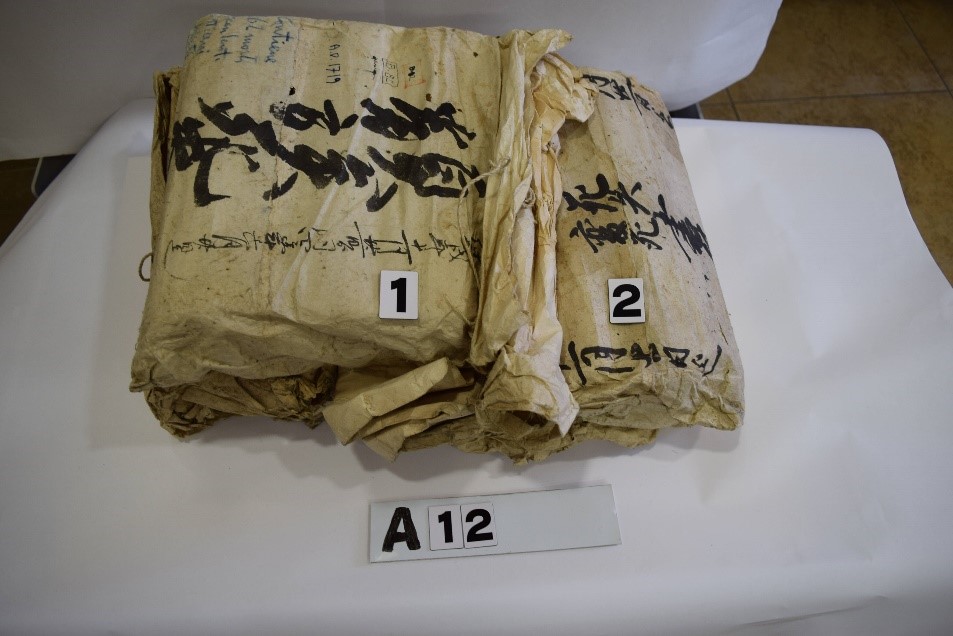- Reference Code
maregaA12
- Title
Fonds Marega File A12
- Date Range
- 1689–1802
- Primary Date Range
- 1889, 1718–1727, 1801–1802.
- Date Range Notes
- 1689 (Genroku 2), 1718 (Kyōhō 3) – 1727 (Kyōhō 12), 1801 (Kyōwa 1) – 1802 (Kyōwa 2)
- Description Level
File
- Quantity
- 1,041 catalogue entries (A12.1.0 to A12.7.78)(12 belt-shaped hōshi 包紙, 23 strings, 1 string with writing on it, 7 bags, 1 slip of paper, 953 jō 状, 43 jō [with harigami 貼紙 / papers attached], 1 hōshi)
- Notes on Physical State
- A12 is comprised of documents that were kept in seven kōzo 楮 (paper mulberry) bags. They were placed in these bags based on their time of creation and content. The date ranges written on the bags and the actual date ranges of the individual documents in them almost entirely match. 95.6% of the documents are jō.
- Provenance / Creation
- Father Mario Marega. The Christian-related materials that he gathered are primarily from the Usuki Domain’s Office of Religious Affairs (shūmonkata 宗門方).
- Place Name
- Ōita City and Usuki City, Ōita Prefecture; Himon’ya, Meguro City, Tōkyō-to
- Positions, etc
- Salesians of Don Bosco Missionary. The vast majority of the Christian-related materials are from Usuki Domain’s Office of Religious Affairs.
- Archival History
- Given in 1953 by Mario Marega to the Vatican.
- Scope and Content
As indicated in “Notes on Physical State,” file A12 is comprised of a group of documents from the Office of Religious Affairs that were in seven bags made from kōzo as well as Marega’s strings, memos, etc. that were with them.
The date ranges and document content descriptions written on the outside of the bags are as follows. (A12 container titles, etc.)
A12.1 21st day of the 11th month of Kyōhō 3 (year of the Dog) to 20th day of the 6th month of Kyōhō 4 (year of the Boar) – Deaths of former Christians’ relatives (342) A12.2 21st day of the 6th month of Kyōhō 12 (year of the Sheep) to 20th day of the 11th month of Kyōhō 12 (year of the Sheep) – Deaths and unusual deaths of former Christians’ relatives (236) A12.3 21st day of the 12th month of Kyōwa 1 (year of the Rooster) to 20th day of the 11th month of Kyōwa 2 (year of the Dog ) – Deaths and unusual deaths of former Christians’ relatives (202) A12.4 21st day of the 6th month of Kyōhō 12 (year of the Sheep) to 20th day of the 11th month of Kyōhō 12 – Births of former Christians’ relatives (59 items) A12.5 21st day of the 12th month of Kyōhō 9 (year of the Dragon) to 20th day of the 6th month of Kyōhō 10 (year of the Snake) – Births of former Christians’ relatives (124) A12.6 (Genroku 2) Bag of documents recording births by workers (10) A12.7 21st day of the 6th month of Kyōhō 11 (year of the Horse) to 20th day of the 11th month of Kyōhō 11 – Births of former Christians’ relatives (80)
The document date ranges and content descriptions written on the bags almost entirely match the actual date ranges and content of the documents in them. The documents in the bags are divided into multiple groups with twine strings, as well as with pulp strips of paper upon which Marega wrote memos in pen. While perhaps a result of the documents being kept in the state they were in when acquired, there is probably a need to further examine how the documents were organized at the Office of Religious Affairs (from where they originated) as well as by Marega.
The documents are almost all tategami 竪紙 (horizontally oriented pieces of paper). There are some kirigami 切紙 (paper with margins cut off), and tsugigami 継紙 (glued together pieces of paper). They are documents related to the birth, death, marriage, and adoption of descendants of Usuki Domain former Christians (honnin 本人) or of descendants of Usuki Domain children who were born when their parent was Christian (honnin dōzen 本人同然). As is written on the bags, most are related to birth and death. The vast majority of people covered are not samurai. Based on their names and other information, it appears that they were Buddhist and Shinto priests, doctors, and so on.
In the main text of birth notifications one finds their relationship to the honnin / honnin dōzen, their name at birth, and date of birth. Their birth parents, place of residence (village name, etc.) and so on are also noted. They were sent by a village unit headman (shōya 庄屋), and addressed to three people at the Office of Religious Affairs (magistrates / bugyō 奉行).
When a relative of a former Christian died, two notifications were created: one from village power-holders for the Office of Religious Affairs, and one from the temple to which they belonged, also for the Office of Religious Affairs. They record the place of residence and name of the honnin / honnin dōzen, the deceased person’s relationship to the honnin / honnin dōzen, the village to which the relative belonged, as well as their date of death and cause of death. The documents also state that there were no abnormalities with the corpse. The senders were the relative’s five-household unit, village officials (benzashi 弁指), and the head of their village unit. The addressees were three people at the Office of Religious Affairs (magistrate). The number of senders varies. Temples’ notifications were primarily the same content as the village notifications (however, they did not include cause of death). They noted whether the body was cremated or buried, and state that the head priest of the temple checked the corpse. The sender is the temple’s head priest, and the addressees were three people at the Office of Religious Affairs (magistrates).
- Languages Used
- Japanese, Italian, English (Newspaper)
- Date Description Written
- 2017/11/13
- Reference Images


